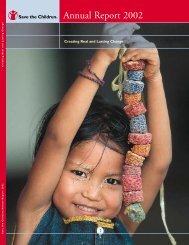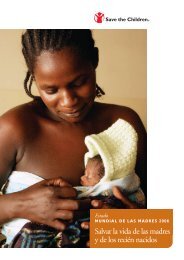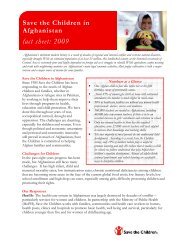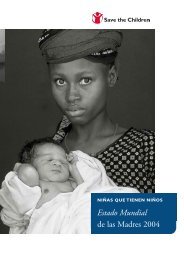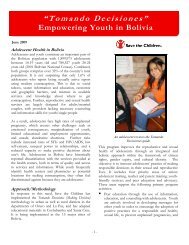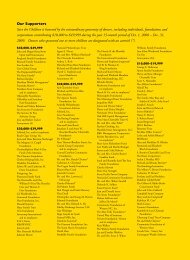Annual Report 2004 - Save the Children
Annual Report 2004 - Save the Children
Annual Report 2004 - Save the Children
Create successful ePaper yourself
Turn your PDF publications into a flip-book with our unique Google optimized e-Paper software.
provide children with opportunities, tools and guidance:<br />
opportunities to improve <strong>the</strong>ir reading and writing skills,<br />
tools such as books, learning materials, literacy games and<br />
computers to develop <strong>the</strong>ir reading comprehension skills, and<br />
guidance and support <strong>the</strong>y need to grow as readers.<br />
£ School Health and Nutrition. Students from 6 to 12 years<br />
of age receive prevention and treatment for malaria, anemia<br />
and intestinal parasites under this school-based program.<br />
The programs also provide vitamin supplementation, potable<br />
water, hygiene facilities, vision and hearing screening, and<br />
health education. In <strong>the</strong> United States, programs provide<br />
children with opportunities for regular physical activity, and<br />
for nutrition to prevent obesity.<br />
Sisters Christine, 12, and Charmine, 11, of Manila, <strong>the</strong> Philippines work on <strong>the</strong>ir<br />
homework.<br />
centers are built and upgraded as part of this program, which<br />
also provides caregivers with supplies and training in child<br />
development, education, hygiene, nutrition and disease<br />
prevention. In <strong>the</strong> United States, programs are providing<br />
training and educational materials including books to<br />
promote parents’ reading to <strong>the</strong>ir preschool children.<br />
£ Primary Education. <strong>Children</strong> aged 6 to 15 attend schools<br />
based on community needs under this program, which builds<br />
and supplies <strong>the</strong> schools as well as training faculty and administration<br />
in active, student-centered education. Curricula<br />
and academic schedules are responsive to local culture. U.S.<br />
education programs focus on improving literacy through<br />
after-school, summer and in-school support. These programs<br />
<strong>Children</strong> at a <strong>Save</strong> <strong>the</strong> <strong>Children</strong>-supported school in Mali.<br />
£ Adolescent Development. Improved learning opportunities<br />
and greater access to health information and health<br />
services help adolescents aged 12 to 18 prepare for <strong>the</strong><br />
challenges facing <strong>the</strong>m as <strong>the</strong>y mature. These programs seek<br />
to ensure a healthier transition to adulthood, with lower rates<br />
of HIV/AIDS and <strong>the</strong> literacy, numeracy and livelihood skills<br />
needed for success in life.<br />
£ HIV/AIDS Care and Prevention. Focusing on <strong>the</strong> needs<br />
of orphans and vulnerable children of all ages, HIV/AIDS<br />
programs provide assistance with school fees, support for<br />
basic food and shelter, economic opportunities for older<br />
children and caregivers, planning for bereavement and<br />
guardianship, and preventive information.<br />
Monitoring and evaluation: a “feedback loop” of<br />
knowledge. <strong>Children</strong> aren’t <strong>the</strong> only ones learning in sponsorship<br />
programs. Central to <strong>the</strong> modernization of sponsorship is its<br />
improved monitoring and evaluation system, or “M&E,” enabling<br />
field workers and technical staff to track <strong>the</strong> performance of<br />
program initiatives more closely than ever before – learning what’s<br />
working and why, so successes can be replicated and streng<strong>the</strong>ned.<br />
“Our updated M&E system is huge news for sponsorship,” says<br />
Moran. “It’s not just for setting and meeting performance goals,<br />
important as that is. It will also enable us to take a closer look at<br />
<strong>the</strong> biggest factors that lead to positive change in children’s lives,<br />
and <strong>the</strong>n make sure that our activities are structured to make <strong>the</strong><br />
most of those factors.” <strong>Save</strong> <strong>the</strong> <strong>Children</strong> launched this new<br />
focus on M&E in 2003; Moran expects <strong>the</strong> new evaluation<br />
methodology to be fully in place by 2005.<br />
Funding trends: continued growth, greater loyalty,<br />
increased flexibility. Since its inception, sponsorship has<br />
been <strong>the</strong> deciding factor behind many contributions and a vivid<br />
showcase for success in <strong>the</strong> field. In <strong>2004</strong> sponsor contributions<br />
accounted for more than $29 million in total donations – up<br />
seven percent over <strong>the</strong> previous year. Retention of sponsors from<br />
year to year has also been improving, and has reached <strong>the</strong> highest<br />
level we have ever recorded – over 84 percent.<br />
26 CRITICAL CHOICES FOR THE WORLD,S CHILDREN


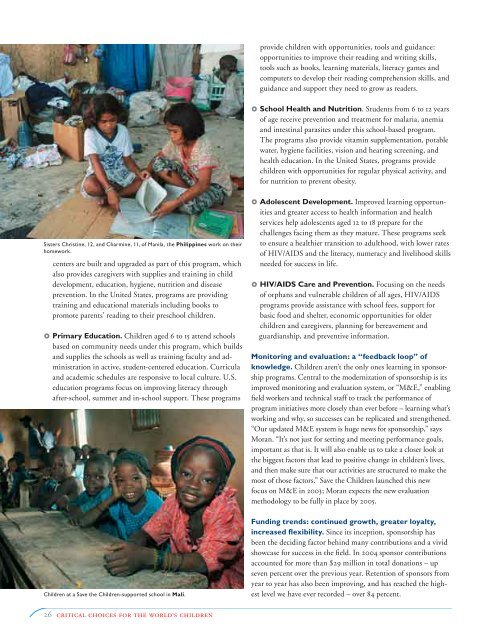

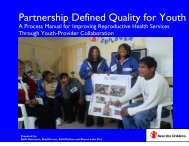

![View full document [PDF 3.39 MB] - PreventionWeb](https://img.yumpu.com/27308954/1/190x245/view-full-document-pdf-339-mb-preventionweb.jpg?quality=85)
